Posts Tagged ‘Experiential Education’
Gardening Program with SAGE Elementary Students
Our Title 1 school is lucky enough to have a decent size outdoor garden that is overseen by community volunteers. One of their goals is to teach our students about the garden.
Because of the that, I offered gardening as a possible elective for my GT (gifted and talented students). See Offering Electives to Elementary Students for more about why and how I offer electives to them. They joyfully selected gardening as one of them.
I also have the privilege of teaching my students multiple years. Along with a brief explanation of the activities for this elective, below is a video about the plants from the outdoor garden that the students created last school year, and one they created this year about our indoor hydroponic garden. (Note: Students are still in the process of composing the individual descriptions of the garden activities they did.)
Description of the Activities
We’ve been shaping our garden, and that comes with a lot of activities during spring and fall. These activities are all very fun. They included: garden class, plant anatomy and good eats. The garden class was very fun. It was basically reading out plant facts from a book. Plant anatomy was where they told us about the plant’s names and different parts.
Outdoor Garden
Our Salazar Green Garden has many diverse types of plants including peppers, tomatoes, rhubarb, mint, two different kinds of plum, peaches, and more! We donate to the Adelante food bank program, a way that Salazar can give back to the community.
Hydronic Garden
Students started a hydroponic garden and successfully grew lettuce, cilantro, spinach, and chives.
Healthy Eating
One of the goals of this program was to teach and have the students enjoy healthy foods.
Connecting School Standards to Gardening Resources
A school garden (however large or small) provides a meaningful context in which students can apply new academic concepts and skills. Whether they are graphing the temperature of their compost pile over time; reading a recipe to make fresh salsa; writing a story from the perspective of an ant; or presenting to a buddy class on the animals that visited their sunflower patch, the opportunities for children to practice traditional academic subjects in the garden are limitless! (Common Core and Next Generation Science in the Garden)
- Standards-Based Learning in a Garden https://www.edutopia.org/practice/garden-based-learning-engaging-students-their-environment
- Connecting the school garden to curriculum standards https://www.canr.msu.edu/news/connecting-the-school-garden-to-curriculum-standards
- From Seed to Plant https://www.monroe.edu/cms/lib/NY02216770/Centricity/Domain/141/fromseedtoplant12-8-15.pdf
Pi Day: An Example of an Interdisciplinary, Engaging Lesson
I have the privilege of teaching my gifted elementary students at two Title 1 schools for multiple years. Each year I have special thematic days for which the students get very excited, e.g., Halloween and Day of the Dead “Wars,” Valentines Day, Book Celebrations, and Pi Day. I love planning a variety of interdisciplinary activities for these days. It is like planning parties. I want to give them memories of positive school experiences that last a lifetime. When I announce these upcoming celebrations, the students who have been in my program for multiple years cheer loudly. My new students then get excited, too.
I’ve blogged about the value of interdisciplinary units before – All Lessons Should Be Interdisciplinary https://usergeneratededucation.wordpress.com/2019/01/13/all-lessons-should-be-interdisciplinary/

Pi Day Activities
The day consisted of the following activities:
- Introduction – Pi Day Trivia
- Book: Sir Cumference
- Kahoot Pi Games
- Digital Breakout
- Making and Decorating Pies
- Measuring for Pi
- Stations
- Pi Fortune Teller
- Pi Sky Line
- Race to Pi Card Game
Standards Addressed
A variety of cross-disciplinary content standards were addressed during this lesson.
Common Core Math Standards:
- CCSS.MATH.CONTENT.7.G.B.4
Know the formulas for the area and circumference of a circle and use them to solve problems; give an informal derivation of the relationship between the circumference and area of a circle. - CCSS.MATH.CONTENT.5.MD.A.1
Convert among different-sized standard measurement units within a given measurement system, and use these conversions in solving multi-step, real world problems.
Common Core English Language Arts Standards:
- CCSS.ELA-LITERACY.RI.6.7
Integrate information presented in different media or formats (e.g., visually, quantitatively) as well as in words to develop a coherent understanding of a topic or issue. - CCSS.ELA-LITERACY.RI.5.10
By the end of the year, read and comprehend informational texts, including history/social studies, science, and technical texts, at the high end of the grades 4-5 text complexity band independently and proficiently.
National Core Art Standards:
- Generate and conceptualize artistic ideas and work.
- Refine and complete artistic work. (https://www.nationalartsstandards.org/)
Pi Day Trivia
Students were introduced to Pi and Pi Day through the following videos:
Sir Cumference
The students then were shown a reading of Sir Cumference and the First Round Table (A Math Adventure) by Cindy Neuschwander:
Join Sir Cumference, Lady Di of Ameter, and their son Radius for wordplay, puns, and problem solving in this geometry-packed math adventure. King Arthur was a good ruler, but now he needs a good ruler. What would you do if the neighboring kingdom were threatening war? Naturally, you’d call your strongest and bravest knights together to come up with a solution. But when your conference table causes more problems than the threat of your enemy, you need expert help. Enter Sir Cumference, his wife Lady Di of Ameter, and their son Radius. With the help of the carpenter, Geo of Metry, this sharp-minded team designs the perfect table conducive to discussing the perfect plan for peace (https://www.amazon.com/Cumference-First-Round-Table-Adventure/dp/1570911525).
Pi Kahoots
My students cheer when we do Kahoot quizzes. The Kahoot quizzes made and submitted by other teachers make it so easy to use. Here are the two Pi Kahoots I did with the students:
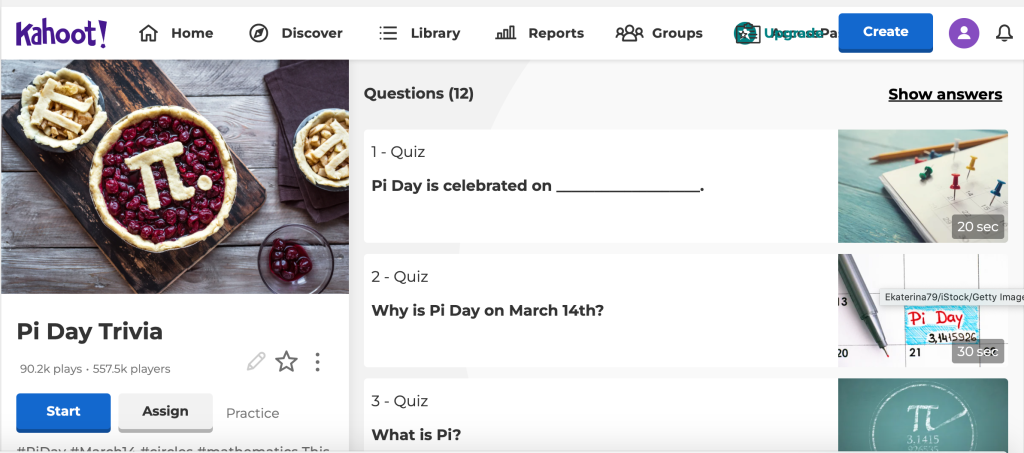
Accessed at: https://create.kahoot.it/details/0210be57-ce68-489a-9054-d9165b8165ff

Accessed at: https://create.kahoot.it/details/pi-day-trivia/a7605cd3-4c93-4c13-bc23-eec96da2a627
Digital Breakout EDU – Pi Day
Breakout EDU is an immersive learning games platform. Breakout EDU games consist of a combination of physical and digital puzzle elements that must be solved in a set amount of time. Players of all ages are challenged to open the locked Breakout EDU box using critical thinking, collaboration and creativity. (https://orrhslibrary.weebly.com/what-is-breakout-edu.html).
Here is the Pi Day Digital Breakout EDU game they did.

Can be accessed at https://platform.breakoutedu.com/game/play/pi-day-digital-breakout-4th-6th-grades-90608 .
Making and Decorating Pies



One of the activities students enjoy the most during Pi day is making pies. They were given ingredients and recipes for:
- Oreo Cookie Pie – https://littlespoonfarm.com/no-bake-lemon-icebox-pie-recipe/
- Lemon Pie – https://littlespoonfarm.com/no-bake-lemon-icebox-pie-recipe/
- Strawberry – https://www.justapinch.com/recipes/dessert/pie/strawberry-icebox-pie.html
- Graham cracker crust (for use in the Pi pan) – https://www.callmepmc.com/how-to-make-a-no-bake-graham-cracker-crust/
- Royal Icing (for decorating the pies) – https://www.chsugar.com/recipe/royal-icing-with-meringue-powder
They needed to follow the recipe which included figuring out the directions and using measurements. I even bought a Pi pan for them to use. After the pies were made, they decorated them with Pi symbols and characters.
Measuring for Pi
With tape measures in hand, groups of students carefully measure the circumferences and diameters of various round objects. The class makes a table of measured values and calculates the quotients. When they see time and time again the same answer result from division, whether it be from big circular objects or small ones—eureka!—they will have unwittingly discovered π for themselves (http://ccssimath.blogspot.com/2013/03/the-life-of-pi.html).
I created a competition to see which team could achieve Pi based on their measurements of diameters and circumferences of real world objects. I watched as they struggled with and learning about circumferences, diameters, and pi; about doing accurate measurement; about converting fractions into decimals to do their calculations; and about using the Pi formula.
Stations
Students could choose from the following stations to complete their Pi days.
Pi Fortune Teller
Pi Graph Skyline
Directions for this activity can be found at https://carrotsareorange.com/pi-day-activities/.
Race to Pi Card Game
Directions can be found at https://mathgeekmama.com/pi-day-card-game/.
A STE(A)M Professional Development Course
I had the privilege of teaching a STE(A)M graduate course for Antioch University [New England]. I thought other teachers might benefit from access to a few of my project assignments and resources as well as example projects that teachers in the course produced.
Course Description
What does it mean to teach and engage our students in our modern world? How might we use principles of STE(A)M to engage all students? How can we design and implement STEM education and design thinking strategies building on our professional priorities (ie., the Critical Skills Classroom, nature based education, arts integration, etc) as well as developmentally appropriate pedagogy? How cam we use technology to support student learning? What’s the difference between STEM, STEAM, and STREAM? These questions will be explored in this online course designed to deepen understanding and inspire teachers to a new level of practice. Students will work both on their own and collaboratively to explore learn about these various topics for practical classroom implementation. Focus will also be given to modern tools to support STE(A)M and learning both face-to-face and virtual environments. Participants will design powerful learning experiences for these classrooms as well as formative and summative assessments. Online course.
STE(A)M Elevator Pitch
Using the resources https://www.pearltrees.com/jackiegerstein/stem-steam-stream-resources/id25727284 as reference, post an “elevator pitch” recording that defines these concepts on Flipgrid – https://flipgrid.com/5ab9c3cb.
https://flipgrid.com/5ab9c3cb?embed=true
Collaboratively Curated Resources
Assignment Description
For the first part of this assignment. individually you are going to do a search for STEM/STEAM related resources from social media such as Twitter, Pinterest, Facebook, Instagram using hashtags (#STEM, #MakerEd, #STEAM, #edtech) to help identify them.
As a group, using a collaborative curation tool and collaborative process, create a curated list of resources that you discovered in the first part of this assignment and may prove useful to the beginning practitioner. Here is a resource to learn more about content curation: http://www.spencerauthor.com/content-curation/.
Here is a list of tools that can be used to collaborative curate your group’s resources. Your group will decide which one to use:
- Pearltrees – https://www.pearltrees.com/
- Tutorial including how to collaborate – https://youtu.be/icP6t-U8iOg
- Wakelet – https://wakelet.com/home
- Tutorial including how to collaborate – https://drive.google.com/file/d/15MPavRhnwSWyHbNucLPadzOXCl_YiIUY/view
Student Examples
- STEM/STEAM/STREAM resources with Wakelet – https://wke.lt/w/s/FQlmYH
- Team #STEM Resources with Pearltrees – http://www.pearltrees.com/t/stem-resources/id27215128
STE(A)M Lesson Plan
Assignment Description
Design a Lesson Plan or Unit that incorporates elements of STEAM. Review the following resources:
- STEM Lesson Plan Format – http://www.stem-by-design.com/wp-content/uploads/2016/07/15034-0026f_Design-Tool-8.1.pdf
- Maker Education Lesson Plan Format – https://usergeneratededucation.wordpress.com/2018/07/06/integrating-maker-education-into-the-curriculum/ and Learning in the Making.
Make sure to include the following elements plus any others you would like to include:
- Topic
- Vision for the Lesson
- Essential Questions
- Cross Curricular Standards Addressed
- Prerequisite Knowledge and Skills
- Vocabulary
- Needed Materials
- Instructional Activities
- The Hook (high impact activity to introduce the lesson to the students)
- Step-by-Step Procedures (needs to have enough details that any other teacher could implement it)
- Reflection (How will students reflect on their learning? See https://usergeneratededucation.wordpress.com/2018/03/10/reflecting-on-maker-experiences-with-reflection-cards/ and Learning in the Making for ideas.
- Any resources used.
Student Examples
STE(A)M Assessment
Assignment Description
Create a list possible strategies to assess students STEM/STEAM projects. It should be tailored to the (expected) age level of your learners, the focus of your learning activities (STEM, STEAM, or STREAM). Discuss several forms of formative and summative assessments that you can draw upon when you teach STEAM-based lessons.
Review the following:
- Documenting Learning: http://www.documenting4learning.com/
- Teaching Tools or STEM Education – Assessment: http://stemteachingtools.org/tgs/Assessment
- Assessing Maker Education Projects – https://usergeneratededucation.wordpress.com/2018/05/05/assessing-maker-education-projects/
- Beyond the Rubric – https://makered.org/beyondrubrics/toolkit/
- Pinterest Aggregate – Assessment Resources https://www.pinterest.com/criticalskills1/assessment/
- 75 Digital Tools and Apps Teachers Can Use to Support Formative Assessment in the Classroom https://www.nwea.org/blog/2019/75-digital-tools-apps-teachers-use-to-support-classroom-formative-assessment/
In developing your strategies and ideas include at least one strategy from each of the following:
- Documenting Learning Strategies (formative)
- Reflecting on Learning (formative)
- Strategies that Leverage Technology, e.g., blogs, podcasts, videos, online tools (formative and summative)
- Assessing the Cross-Curricular Standards and Goals Associated with STEAM Education (formative and summative)
- Going Beyond the Rubric (formative and summative)
You can share it in written form or create your version of assessment ideas using one of the following EdTech tools (they have free versions):
- Book Creator ebook – https://bookcreator.com/
- Piktochart Infographic (one of my favorites) – https://piktochart.com/
- Storyboard That Comic – https://www.storyboardthat.com/
- Google Site website – https://sites.google.com/
- A Podcast or Video
Student Examples
Final Course Reflection
Description
The goal of this reflective piece is the documentation of your understanding of the standards for this course, based in both your learning in class and in your experiences. The format of this piece is up to you but it must demonstrate that you understand the following:
- How do you define STE(A)M education within your context? (Please include specific examples of experiential learning: project, problem, place, and design challenge learning and any other relevant methodologies.)
- What are the key ideas that should guide you in making good choices about the selection, acquisition, organization, evaluation, and reconsideration of resources and activities related to STE(A)M?
- What are your next steps to support yourself and others in implementation of STE(A)M curriculum?
- What skills and knowledge do you need to further develop in order to develop your expertise in STE(A)M instruction?
Student Example
Pi Day: An Example of an Interdisciplinary, Engaging Lesson
I have the privilege of teaching my gifted elementary students for multiple years. At my one school, I have them in class for a full day each week, and each year I have special thematic days for which the students get very excited, e.g., Halloween and Day of the Dead “Wars,” Valentines Day, Book Celebrations, and Pi Day. I love planning a variety of interdisciplinary activities for these days and I love watching how 100% are fully engaged for the entire time.
I’ve blogged about the value of interdisciplinary units before – All Lessons Should Be Interdisciplinary https://usergeneratededucation.wordpress.com/2019/01/13/all-lessons-should-be-interdisciplinary/

Pi Day Activities
The day consisted of the following activities:
- Digital Breakout
- Making and Decorating Pies
- Book: Sir Cumference
- Measuring for Pi
- Kahoot Pi Games
Standards Addressed
Common Core Math Standards:
- CCSS.MATH.CONTENT.7.G.B.4
Know the formulas for the area and circumference of a circle and use them to solve problems; give an informal derivation of the relationship between the circumference and area of a circle. - CCSS.MATH.CONTENT.5.MD.A.1
Convert among different-sized standard measurement units within a given measurement system, and use these conversions in solving multi-step, real world problems.
Common Core English Language Arts Standards:
- CCSS.ELA-LITERACY.RI.6.7
Integrate information presented in different media or formats (e.g., visually, quantitatively) as well as in words to develop a coherent understanding of a topic or issue. - CCSS.ELA-LITERACY.RI.5.10
By the end of the year, read and comprehend informational texts, including history/social studies, science, and technical texts, at the high end of the grades 4-5 text complexity band independently and proficiently.
ISTE Standards for Students:
- Students plan and employ effective research strategies to locate information and other resources for their intellectual or creative pursuits.
- Students collect data or identify relevant data sets, use digital tools to analyze them, and represent data in various ways to facilitate problem-solving and decision-making.
21st Partnership for 21st Century Skills:
- Collaborate with others
- Demonstrate ability to work effectively and respectfully with diverse teams
- Exercise flexibility and willingness to be helpful in making necessary compromises to accomplish a common goal
- Assume shared responsibility for collaborative work, and value the individual contributions made by each team member
Digital Breakout EDU – Pi Day
So what is this about Digital Breakout EDU games? Simply put, it’s taking the same concept, but turning it all digital. Participants are given a one-page site that includes text, images and links to clues, some of which may be misleading. There is a Google Form embedded on the page where you submit your answers to a series of “lock” questions and each lock will immediately tell you if you’re successful (http://wordpress.barrow.k12.ga.us/21stcenturytips/?p=6989).
To start off our Pi day activities, students did a Pi Day Digital Breakout EDU game.

Can be accessed at https://platform.breakoutedu.com/game/play/pi-day-digital-breakout-4th-6th-grades-90608 .
Making and Decorating Pies


One of the activities students enjoy the most during Pi day is making pies. They were given ingredients and recipes for:
- Apple Pie – https://www.thespruceeats.com/easy-apple-pie-recipe-for-kids-2097625
- Chocolate Peanut Butter Pie – https://happyhourprojects.com/chocolate-peanut-butter-pies/
- Royal Icing (for decorating the pies) – https://www.chsugar.com/recipe/royal-icing-with-meringue-powder
They needed to follow the recipe which included figuring out the directions and using measurements. After the pies were made, they decorated them with Pi symbols.
Sir Cumference
The students then were shown a reading of Sir Cumference and the First Round Table (A Math Adventure) by Cindy Neuschwander:
Join Sir Cumference, Lady Di of Ameter, and their son Radius for wordplay, puns, and problem solving in this geometry-packed math adventure. King Arthur was a good ruler, but now he needs a good ruler. What would you do if the neighboring kingdom were threatening war? Naturally, you’d call your strongest and bravest knights together to come up with a solution. But when your conference table causes more problems than the threat of your enemy, you need expert help. Enter Sir Cumference, his wife Lady Di of Ameter, and their son Radius. With the help of the carpenter, Geo of Metry, this sharp-minded team designs the perfect table conducive to discussing the perfect plan for peace (https://www.amazon.com/Cumference-First-Round-Table-Adventure/dp/1570911525).
Measuring for Pi


With tape measures in hand, groups of students carefully measure the circumferences and diameters of various round objects. The class makes a table of measured values and calculates the quotients. When they see time and time again the same answer result from division, whether it be from big circular objects or small ones—eureka!—they will have unwittingly discovered π for themselves (http://ccssimath.blogspot.com/2013/03/the-life-of-pi.html).
Pi Kahoots
Using Kahoot wasn’t planned for the day but the students asked for it. I love that they ask for learning tasks. The Kahoot quizzes made and submitted by other teachers make it so easy to use them spontaneously. Here are the two Pi Kahoots I did with the students:

Accessed at: https://create.kahoot.it/details/pi-day/877d64ee-3003-4a30-9d82-f1cd81721749

Accessed at: https://create.kahoot.it/details/pi-day-trivia/a7605cd3-4c93-4c13-bc23-eec96da2a627
A STEM Camp for Young Learners
I just finished a week long – half day STEM camp for learners, ages 7 through 12, half girls and half boys. The energy in the room throughout the week was pretty incredible. There was close to 100% engagement the entire time which is always my goal in teaching. I love turning kids onto STEM, and there is evidence that exposure at a younger age increases the chances of later interest.
Some Evidence of the Importance of STEM in the Early Years
Research tells us that children’s early experience builds brain architecture and lays the foundation for one’s lifelong thinking skills and approach to learning, both critical roots of STEM success. After all, the STEM disciplines require not only content knowledge but also robust thinking dispositions—such as curiosity and inquiry, questioning and skepticism, assessment and analysis—as well as a strong learning mindset and confidence when encountering new information or challenges. These need to be developed in a child’s early education, beginning in infancy and continuing through third grade to lay the roots for STEM success. (McClure et al., 2017) (The Roots of STEM Success: Changing Early Learning Experiences to Build Lifelong Thinking Skills)
According to a new research project, children who engage in scientific activities at an early age (between birth and age 8) develop positive attitudes toward science, build up their STEM “vocabularies” and do better at problem solving, meeting challenges and acquiring new skills. “STEM starts early: Grounding science, technology, engineering and math education in early childhood,” published by the Joan Ganz Cooney Center at Sesame Workshop and New America and supported by a National Science Foundation grant, has asserted that “the seeds of STEM must be planted early,” right alongside the “seeds of literacy.” Together, the report said, “these mutually enhancing, interwoven strands of learning will grow well informed, critical citizens prepared for a digital tomorrow.” (Research: Let’s Move STEM Learning Earlier)
The Camp
Due to the experiential nature of most of my instruction, I use an experiential cycle of learning:

What follows is how I applied it during the STEM camp.
Framing the Activities
The STEM activities were introduced through (1) the use of Brainpop videos and their accompanying quizzes, and (2) tutorial videos and/or webpages with directions. Brainpop videos, due to their animation and humor, have a high interest value for kids, and their follow-up quizzes help to create more active learning. After the Brainpop video introduction, the campers were given an overview of the specific activities through the tutorials. I then would show them the tutorial step-by-step. For some campers, seeing the tutorial in its entirety was enough for them to do the project. Others needed me to go over the project step-by-step using the tutorials as guides. I prefer using online tutorials rather than doing them myself as demonstrations because the tutorials can be projected for a larger image and better viewing by all of the learners.
These specific resources can be found in the slide deck below:
The Doing
The camp consisted mostly of campers DOING the STEM activities. See below for a photographic journey of their engagement in the activities.
Reflection
Activity reflections occurred after the completion of the day’s activities using science journals:

https://www.lakeshorelearning.com/products/el/s/HH258
Journals such as these not only benefit the learners but the educator, too. They provide such good activity evaluation information. For example, the last day of camp, students selected two photos from the week from all of the week’s photos that represented their favorite activities. These were printed for them and they then glued the images into their journals and wrote about them. They then did a verbal check-in to tell the rest of us which ones they selected and why.


When they were sharing these with the rest of the group, one of the girls mentioned that the DIY crystals was her favorite. I was totally surprised. I thought this activity was a dude as the kids didn’t seem that excited about them. I was thinking about dropping it as a STEM activity in the future but now I will, due to her comment, consider using it again.
Our Week in Images
Chemistry – Elephant Toothpaste
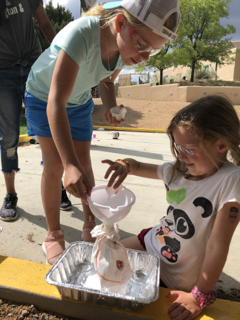

Chemistry – Slime


Chemistry – Orbeez Stress Balls


Solar – Solar Cars


Solar – Solar Ovens


Art and Science – Geometric Structures


Art and Science – DIY Crystals
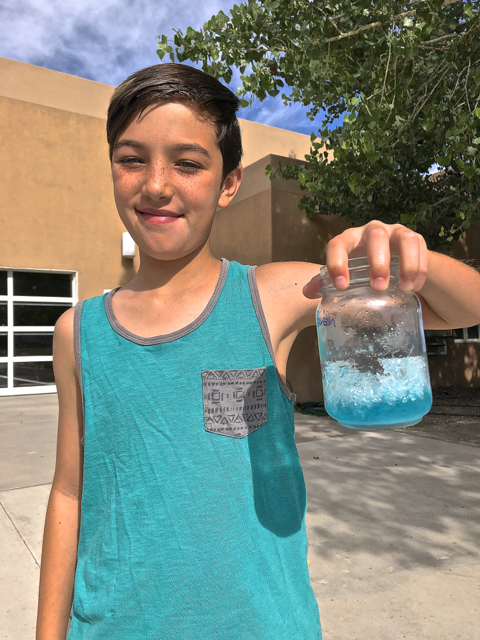

Kinetic Projects – Cranky Contraptions


Kinetic Projects – Helium Balloon Blimp


Kinetic Projects – Motor Boats


Focusing on the Process: Letting Go of Product Expectations
I am a process-oriented educator. I focus on how to learn rather than what to learn. I’ve addressed this in Freedom to Learn:

In order to facilitate these desired elements of learning, I believe it is important to focus on the process of learning rather than the products of learning.
When learning is viewed as a product, and the same performance measure applies to all students, learning facilitation can be reduced to cookie-cutter teaching: same pieces of information and instruction are seen sufficient for all students. In a product-centered learning environment emphasis is often in doing activities – worksheets, charts, pre-designed projects – that are either teacher-made or provided by the publisher of the curriculum. The important part of completing these products is getting them right because these products are usually graded! Skilled and obedient students comply with these requests and try hard to get their tasks done right, yet there are many students who just leave them undone.
What about viewing learning as a process? Because students begin their daily/weekly/yearly learning from different levels of knowledge and understanding, they also will end up in different competency levels. And that is okay, honestly. We are not clones. Students shouldn’t be treated like ones. When learning is understood primarily as a process of acquisition and elaboration of information, the natural consequences in the classroom are ongoing differentiation and individualization. Approaching learning as an individual process helps us refocus learning and teaching: the student is in the nexus of her/his own learning, (Is Learning a Product or a Process?)
The following principles from Rogers’ Freedom to Learn are directly addressed when the process of learning becomes the intent of instructional practices:
Much significant learning is acquired through doing. “Placing the student in direct experiential confrontation with practical problems, social problems, ethical and philosophical problems, personal issues, and research problems, is one of the most effective modes of promoting learning” (p. 162).
Learning is facilitated when the student participates responsibly in the learning process. “When he chooses his own directions, helps to discover his own learning resources, formulates his own problems, decides his own course of action, lives with the consequences of these choices, then significant learning is maximized” (p. 162).
The most socially useful learning in the modern world is the learning of the process of learning, a continuing openness to experience and incorporation into oneself of the process of change. If our present culture survives, it will be because we have been able to develop individuals for whom change is the central fact of life and who have been able to live comfortably with this central fact. They will instead have the comfortable expectation that it will be continuously necessary to incorporate new and challenging learnings about ever-changing situations. (pp. 163-164)
Weibell, C. J. (2011). Principles of learning: 7 principles to guide personalized, student-centered learning in the technology-enhanced, blended learning environment. Retrieved from https://principlesoflearning.wordpress.com.
To truly focus on the process rather than products of learning, the educator needs to let go of expectations about the specific products that should be produced by the students. There are expectations regarding some of the processes in which learners should engage (e.g., divergent thinking, questioning, researching, creating, innovating) but the educator lets go of the pictures in her or his mind about what the products should look like.
The benefits for my learners include:
- They are not limited by my expectations nor the expectations of a lesson or assessment developed by an outside entity (e.g., textbook or testing company).
- Their engagement, motivation, curiosity, and excitement increase.
- They learn to tolerate and then embrace ambiguity.
- Natural differentiation and individualization result.
- They learn skills such as self-directed learning, taking initiative, locating resources, asking for help that can be transferred to all learning endeavors.
- It reflects and models how learning occurs outside of school.
- There is an increased investment and pride in their work.
- They develop both a sense of confidence and a sense of competence.
The benefits for me, as the educator, include:
- I work hard to pre-plan process-oriented classroom activities but the learners work harder than me during class time. Students should work harder than the educator during class time.
- I am continually surprised at and elated about what learners produce. Because of this, I get to learn from them, too. We become a learning community.
- I get to directly observe how each individual student approaches learning tasks. This furthers my ability to plan learning tasks tailored to the learners’ unique abilities and interests.
- I get to experience the joy with them as they accomplish a learning task on their own using their own personal abilities, intelligence, learning strategies, and struggles. This joy rarely occurs with standardized curriculum and assessments.
Here are some examples of process-oriented learning activities I have done with my students:
- Design Thinking Activities for Elementary Students
- Designing a Video Game
- Maker Education Activities
- Circuit Crafts https://usergeneratededucation.wordpress.com/2017/07/08/maker-education-camp-circuit-crafts/
- Cardboard Creations https://usergeneratededucation.wordpress.com/2017/06/18/cardboard-creations-a-maker-education-camp/
- Toy Hacking https://usergeneratededucation.wordpress.com/2017/04/08/toy-take-apart-and-hacking/
- Rube Goldberg Machines https://usergeneratededucation.wordpress.com/2016/11/29/simple-and-rube-goldberg-machines-a-maker-education-steam-lesson/
- Halloween Wars
Exploring Wealth Inequities: An Experiential Learning Activity
One of the legacies I want to leave with my students (of all ages) is a desire to engage in global stewardship. For more about this see my post, Empathy and Global Stewardship: The Other 21st Century Skills.
As part of my gifted education classes, I am asking my 5th and 6th graders to choose, explore, research, and report via their own Google Sites on one or two of the 17 Global Goals found at The World’s Largest Lesson. Here is the list of global goals selected by my students:

To supplement their online work, I am doing a series of experiential activities with them (FYI – this also supports my desire to balance technology and no technology activities, where student need to communicate and collaborate with one another without the use of devices). We began these activities with Exploring Wealth Inequalities, which I explain below.
Goals
- Explore inequalities of wealth and better understand experiences of economic inequality.
- To graphically demonstrate the vast differences in wealth between different areas of the world.
- Generate ideas for action towards economic equality.
The Task
To use the supplies given to your group to create a model city.
Materials
- Masking Tape – both for creating the boundaries and for building
- Paper or Plastic Cups
- Straws
- Index Cards
- Candy such as M&Ms, Skittles, Hersey’s Kisses.
- Paper Bags
The Set-Up
The setting below is set up prior to the learners’ arrival.

Randomly separate learners into three different groups. Bring them to their area one group at a time and explain the task.
The Wealthy Group:
The wealthy group has more area in which to work, more supplies, and bags of candy with much more than enough for each learner. The facilitator explains the task offering lots of help if they ask for it. They can leave the boundaries of their area. If they ask for more supplies or goods, the facilitator will get it for them – taking it from another group if needed. An unspoken, hidden rule is that they can offer and give any of their supplies to the lower income groups.
The Middle Income Group:
The middle group has everything in moderation – a moderate amount of area to work in – a moderate amount of supplies to build their city. They each get a bag of candy with a few pieces of candy per bag. The facilitator explains the task but doesn’t offer support.
The Poorest Income Group:
This group is given a taped off area in which there is very little room to move; very limited supplies; and a few pieces of candy to share among the group members. The facilitator briefly and impatiently explains the directions to build a model city with the supplies provided.
Debriefing
Students are shown the following video:
. . . and then discuss the following questions:
- Were you treated fairly?
- What aspects of this game represented how the world’s wealth and power are distributed?
- How did the members of the different groups feel about their situation?
- After playing this game do you have a better understanding of the situation or attitude of poor people/nations? Of the situation or attitude of wealthy people/nations?
- Who are the “haves” and the “have nots” in the world today? Who are the “haves” and “have nots” in our country today? In our state or community? Why?
- Should the “haves” be concerned about the situation of the “have nots?” For what reasons? economic? moral/religious? political? Why might the “haves” give money or resources to the “have nots”? Is this a way to solve the problems of poverty?
- What might the “have-nots” do to improve their situation? What are some actions that “have-nots” have taken around the globe and at home to address the inequalities of wealth and power?
- Do you think there should be a redistribution of wealth and power in this country? Why or why not? If yes, how would you propose to accomplish this? What principles would guide your proposals for change?
- Do you think there should be a redistribution of wealth and power throughout the world? Why or why not? If yes, how would you propose to accomplish this? What principles would guide your proposals for change?
(http://hrlibrary.umn.edu/edumat/hreduseries/tb1b/Section2/activity2.html)
Here are some of the comments from my students during the debrief.
Scaffolding Maker Education Learning Experiences
I often read via social media about the importance of student centered, student-driven instruction. I wholeheartedly agree. My blog post is called User-Generated Education for a reason. I also believe one of the roles of an educator, in the context of maker education, is to scaffold learning experiences so the end result is students becoming self-determined learning.
Thinking about the importance of learner autonomy and independence reminded me of my early career when I did counseling work with at-risk youth in wilderness settings, taking them on 2 to 3 week wilderness trips. We did what was called Huddle-Up Circles. Huddle-ups were called by the instructors and/or the youth participants any time a concern or problem arose. Everyone stopped what they were doing to gather in a circle to discuss the problem and generate solutions. Needless to say, the instructors were the ones who most often called and facilitated the huddle-ups at beginning of our trips. Our goal, as instructors and counselors, was to have the young people run the huddle-ups themselves. We knew we were successful when we asked to step out of the huddle-ups by the young people because they wanted to run their own huddle-ups. During these times, we would stand outside of the huddle-up circles and silently observe their processes, only stepping in upon their request. The results not only included the development of skills and strategies for their own social-emotional development, but their success with their earned independence boosted their self-esteems.
This is how I approach facilitating maker education activities. Direct instruction is provided through structured and prescribed activities with the goal of learners then being able to eventually go into self-determined directions. There has been some criticism leveraged against out-of-the-box maker education kits, programmable robots, and step-by-step maker activities. My contention is that learners often don’t know what they don’t know; and that giving them the basic skills frees them to then use their creativity and innovation to take these tools into self-determined directions.
In response, I created and proposed Stages of Maker Education:

In my robotics and coding classes, I use Ozobot, Spheros, Dash and Dot, microbits, Scratch, to name of few. I use a full spectrum of activities starting with direct instruction associated with the Copying stage, then assisting learners to move through the Advance, Modify, and Embellish stages by providing them with examples and resources, and finally, encouraging them to move into the Create stage. Sometimes I show them examples of possibilities for the Create stage. I show such examples to spark and ignite their creative juices. Because almost all of my learners have not had the freedom to create, these examples help to get them motivated and going. Here some are examples of two ends of the spectrum – Prescribed/Copy and Create – of some of these robotic and coding activities to show how learning basic skills can lead to creative activities:
- Ozobot:
- Prescribed/Copy – Ozobot Basic Training
- Create – for creative use of Ozobot examples see https://youtu.be/2C-jbsfBJvA and https://youtu.be/OtUXrVGW3r0 (One of my groups of gifted students are currently working on their own projects to tell a story with Ozobot. I will add their stories once they are completed.)
- Dash and Dot:
- Prescribed/Copy – Teacher-driven lessons found at https://education.makewonder.com/curriculum/learn-to-code
- Create -for examples of the creative use of Dash, see Creativity Corner found at https://www.makewonder.com/play/ideas/
- Scratch:
- Prescribed/Copy – Using Scratch Cards and/or doing Scratch Starter Projects
- Create – for creative examples of Scratch, see https://scratch.mit.edu/studios/232765/
- Sphero:
- Prescribed/Copy – beginning coding activities found at https://edu.sphero.com/cwists/category
- Create – for ways that Sphero creatively for cross-curricular activities, see http://stemeducationguide.com/classroom-activities-sphero/
- micro:bit:
- Prescribed/Copy – step-by-step projects found at https://makecode.microbit.org/# and https://makecode.microbit.org/projects
- Create – for examples of creative projects using micro:bits, see http://microbit.org/en/2017-04-12-mothers-challenge-winners/
My ultimate goal is to have students drive their own learning and I want to help them learn skills to be successful in their self-determined learning.
Qualities of Effective Educator Professional Development
Most administrators and teachers believe in the importance and value of professional development. Sadly, though, too many teachers believe that those mandatory, one-size-fits-all professional development sessions offered by their schools are a waste of time and money.
Randi Weingarten, president of the American Federation of Teachers, said in a statement, “Even high quality professional development must be directly relevant to the needs of teachers and genuinely improve teaching and learning.” Weingarten said. “And low-quality professional development, frankly, feels like detention.” (New Report Reveals That Teacher Professional Development Is Costly And Ineffective)
Teacher professional learning is of increasing interest as a critical way to support the increasingly complex skills students need to learn in order to succeed in the 21st century. Sophisticated forms of teaching are needed to develop student competencies such as deep mastery of challenging content, critical thinking, complex problem solving, effective communication and collaboration, and self-direction. In turn, effective professional development (PD) is needed to help teachers learn and refine the instructional strategies required to teach these skills. However, research has noted that many professional development initiatives appear ineffective in supporting changes in teachers’ practices and student learning.(Effective Teacher Professional Development)
What follows are the general guidelines I use to plan and structure my professional development workshops. Recently, I facilitated two weekends of math instruction for elementary teachers. I use these workshops as a reference in this discussion.
- Voluntary
- Models Best Classroom Practices
- Active and Hands-On
- Fun and Engaging
- Engages the Mind, Body, Emotions
- Time to Tinker and Play
- Collaboration
- Ability to Tailor to Own Needs
- Natural Integration of Technology
- Reflection Built In

Voluntary
Teacher PD needs to be voluntary.
The fact that adults are voluntary participants in the learning situation has profound implications for how learning occurs. They are generally highly motivated and primed to get the most out of the situation as possible. They will tackle tasks with enthusiasm, provided they are seen as relevant. This means that they are more likely to embrace participatory learning techniques such as discussion, role playing, small group work and the analysis of personal experiences.
The reverse side of voluntary participation by adults is that they can just as easily withdraw. Unlike the disruption that occurs when participation is mandatory, adults are likely to do one of two things. They will either quietly withdraw altogether or, if that is not really an option, they will continue to show up and do what is minimally expected of them, but will essentially become passive participants. (Principles underlying Effective Practices in Adult Education)
My weekend math workshops were offered to elementary teachers in a specific school district as a voluntary opportunity. A grant did provide them with a stipend for attending but as one of the attending teachers noted, “Even with a stipend, I wouldn’t volunteer for a weekend workshop unless I was interested in learning how to be a better teacher of math” (in this case).
Models Best Classroom Practices
First and foremost, teacher PD needs to model best classroom practices. “Curricular models and modeling of instruction provide teachers with a clear vision of what best practices look like” (Effective Teacher Professional Development). If the desire is to have educators create and implement engaging, interactive, and fun learning activities, then PD needs to be a mirror of these practices. I always believed that is is hypocritical to lecture about these best practices. It should be a process of modeling.
In order to model best classroom practices during my math workshops:
- I used videos, mostly from The Teaching Channel, to show elementary teachers modeling best practices in math within their own elementary classrooms.
- I did math activities with the teacher participants as if they were students in my elementary classroom.
Active and Hands-On
Active learning engages teachers directly in designing and trying out teaching strategies, providing them an opportunity to engage in the same style of learning they are designing for their students. Such PD uses authentic artifacts, interactive activities, and other strategies to provide deeply embedded, highly contextualized professional learning. This approach moves away from traditional learning models and environments that are lecture based and have no direct connection to teachers’ classrooms and students. (Effective Teacher Professional Development)
Other than explaining activities, showing videos and presenting some technology options, all of learning activities during the weekend workshop were hands-on and active.


Fun and Engaging
Somewhere along the line of professional development, it became a way too serious endeavor. I believe this is a major reason why teachers don’t enjoy their professional development opportunities.
Fun has a positive effect on motivation levels, determining what we learn and how much we retain. If the learning isn’t fun, it won’t be effective. That’s not just a sneaking suspicion – it’s cold, hard, scientific fact.
- A study in the journal, College Teaching, found that students could recall a statistics lecture more easily when the lecturer added jokes about relevant topics.
- In her book, Neurologist, Judy Willis showed how fun experiences increase levels of dopamine, endorphins, and oxygen – all things that promote learning.
- In a study for the Journal of Vocational Behaviour, Michael Tews found that employees are more likely to try new things if their work environment is fun. (Why Fun in Learning is Important)
Regardless of age, grade, content area, one measure of success I use is the quantity of laughter and squeals of joy. I heard lots of laughter during my workshops.
Engages the Mind, Body, Emotions
As an experiential educator and regardless of the age level I am teaching, I emphasize multi-sensory, whole person learning.
We learn best when we think, feel and do. That’s the message of Dr. Adele Diamond, a cognitive developmental neuroscientist who currently teaches at the University of British Columbia in Canada. We might refer to this as “whole body learning.” According to Dr. Diamond, the executive function of the brain — the prefrontal cortex — works best when we go beyond the rational mind by also involving emotions and physical behaviors. That makes sense since the more we involve other parts of the brain, the more neural connections we make that reinforce learning. (Brain Research: To Improve Learning, Use Whole Body)
My math workshop was not exception as activities that use the body, mind, and emotions were introduced to the participating teachers.
Time to Tinker and Play
Teachers and librarians, like their students, need hands-on experience with tools and with playing to learn as that helps them build creative confidence. (Crafting Professional Development for Maker Educators)
Teachers, during PD, should be provided with time, resources, and materials with which to play. It sets the expectation that they will be active agents of their own learning. It gives them the message it is okay to play and experiment with the materials; that tinkering is often needed as a part of learning new skills.
Given that the nature of the workshop was hands-on and active, workshop participants were time to tinker with the resources and materials provided.
Ability to Tailor to Own Needs
One of the justified complaints of teachers regarding their schools’ professional development is that it is often of the too generic, one-size-fits all variety. To be effective, professional develop should help teachers address their own classroom needs. Participating teachers were given lots of resources and opportunities to develop math activities specific for their grade level and students.
Integrates Collaboration
High-quality PD creates space for teachers to share ideas and collaborate in their learning, often in job-embedded contexts. By working collaboratively, teachers can create communities that positively change the culture and instruction of their entire grade level, department, school and/or district. (Effective Teacher Professional Development)
At the beginning of the workshop, participants were asked to form groups with same grade level teachers forming what I called mini-PLNs. Part of the workshop time was devoted to teachers developing materials for their own classrooms and students. During the time, the teachers could work with their mini-PLNs. They were also asked to share, throughout the weekend, the activities they discovered and developed. These sharing sessions often led to feedback and ways the activities could be modified for a variety of student populations.


Naturally Integrates Technology
Technology use within all learning and teaching environments including professional development should be ubiquitous; it’s use should be determine by its potential to enhance and increase learning.
During my math workshop, participants used technology to:
- Access the workshop slides.
- Explore learning activities for the manipulatives I provided: dice, pool noodles, Legos. playing cards, beach balls.
- Try out online math games: ABCya, Toy Theater Math, Prodigy, and Code.org.
- Take photos of math examples in school building.
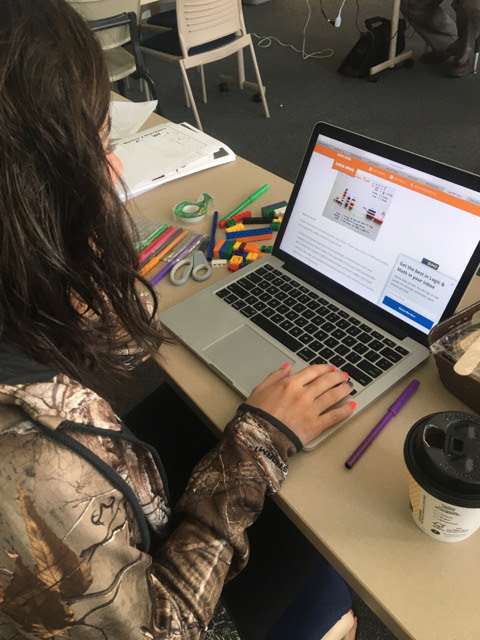

Builds in Reflection
High-quality professional learning frequently provides built-in time for teachers to intentionally think about, receive input on, and make changes to their practice by facilitating reflection and soliciting feedback. Feedback and reflection both help teachers to thoughtfully move toward the expert visions of practice. (Effective Teacher Professional Development)
As a final reflection for the weekend, I asked participating teachers to use the following prompt to create a mini-poster of their learning. It also modeled how to use such a reflection process with their students.
. . . and here is a video recording of one of the participating teacher’s reflections:
As a parting shot, here are the slides I used during the workshop:
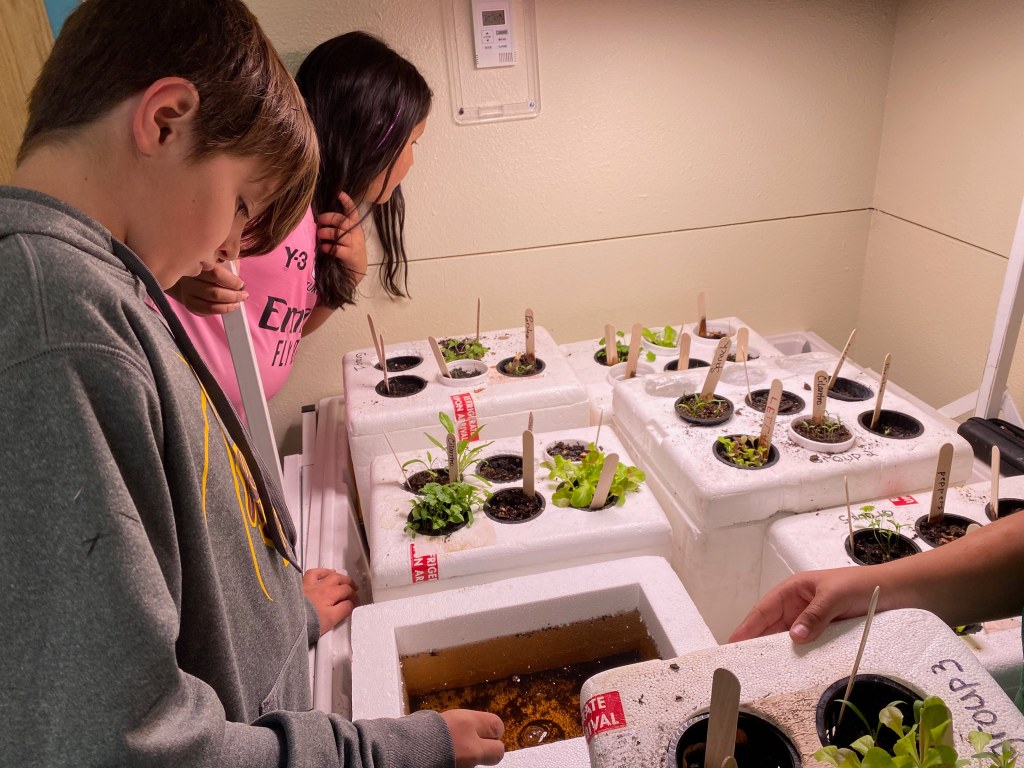
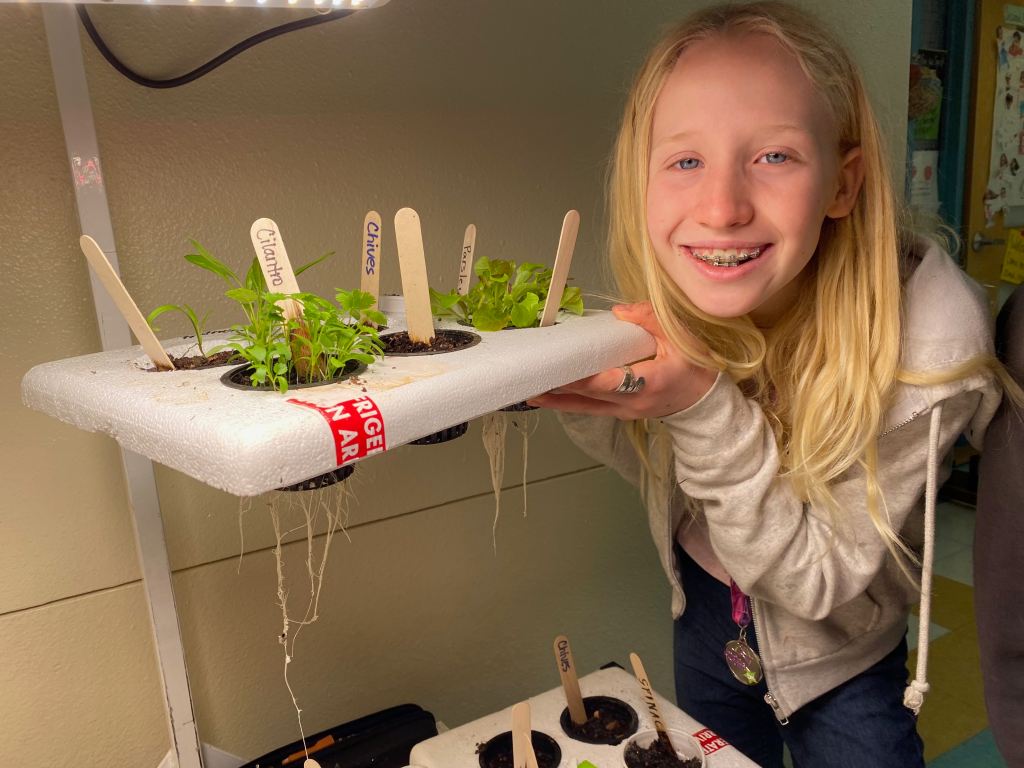
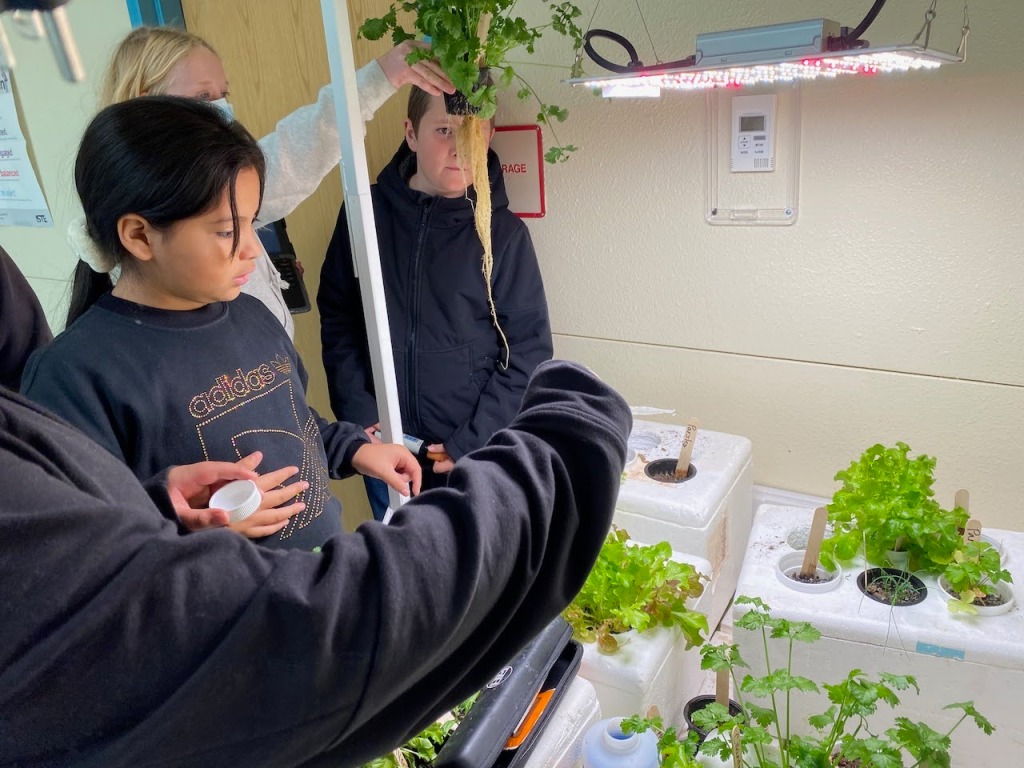
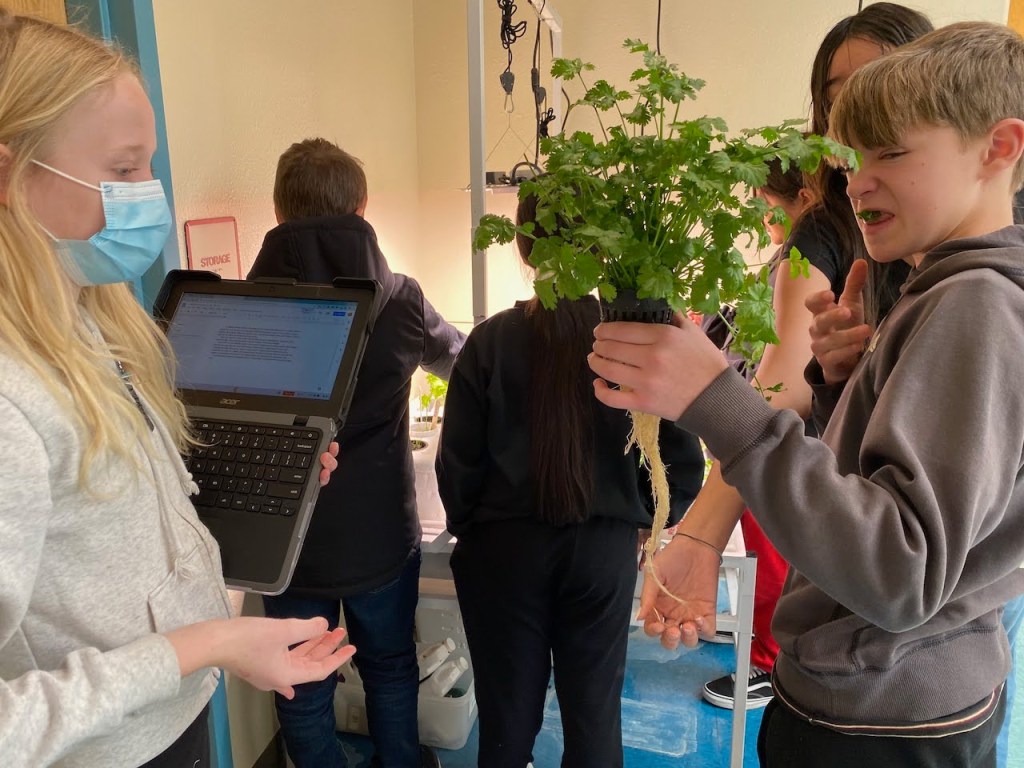
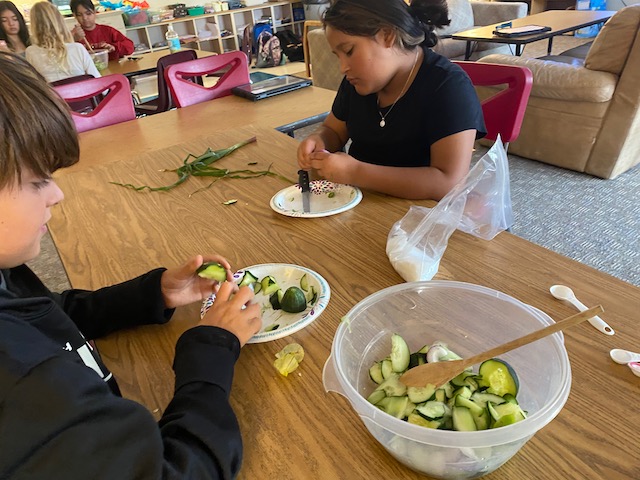


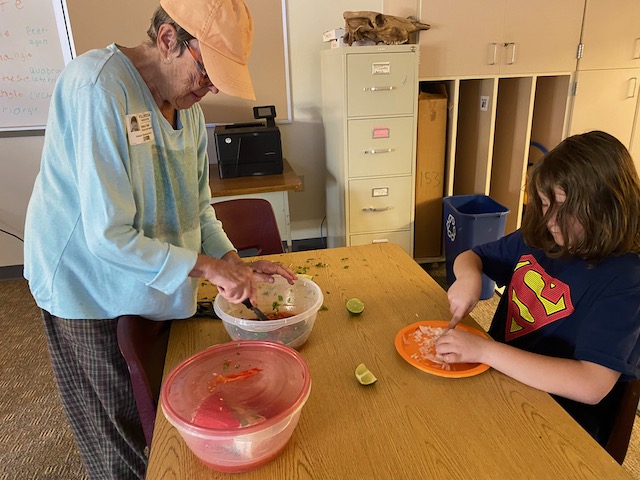






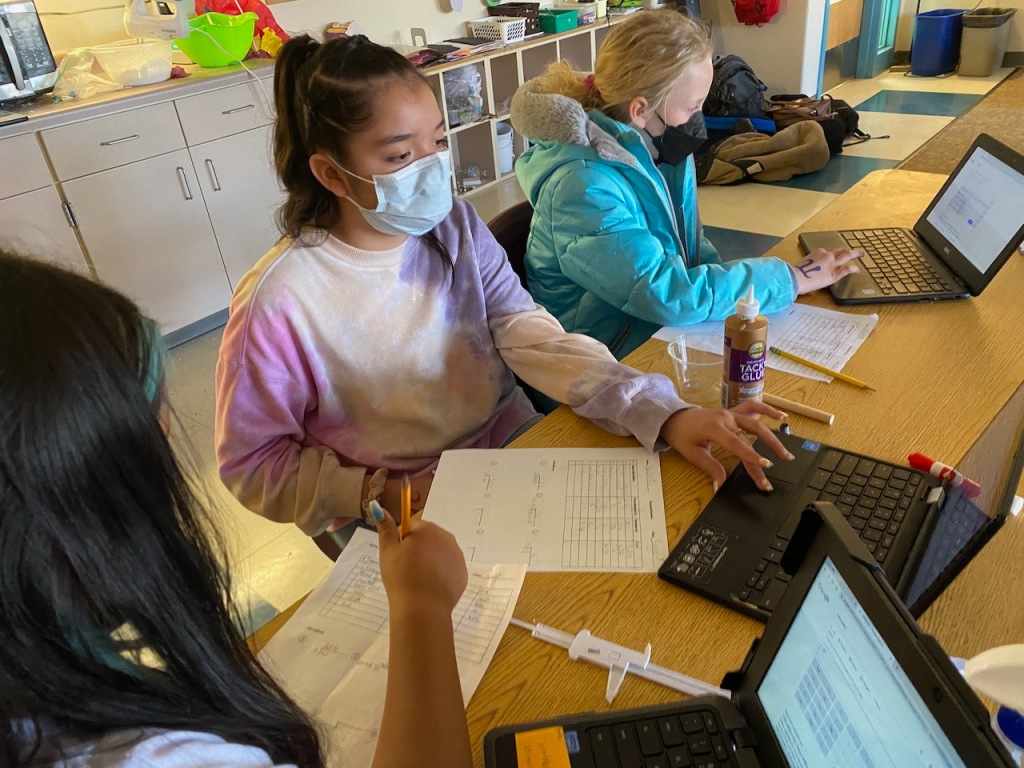







 During one of my maker education workshops, one of the participants finished the basics of the introductory LED paper circuit activity. While the other participants were adding their artistic slants, J. sat there with her simple paper project seemingly satisfied with her project. I went over to talk to her. She said that she was finished, and I said back to her, “That’s fine. You don’t have to do any embellishments if you choose not to.” She later told me of a second grade teacher who criticized her art (yikes – that teacher should have been fired). J. told me later that this acceptance of where she was at actually became encouragement for her to take some risks for later projects in the workshop. Her reflective piece included the following:
During one of my maker education workshops, one of the participants finished the basics of the introductory LED paper circuit activity. While the other participants were adding their artistic slants, J. sat there with her simple paper project seemingly satisfied with her project. I went over to talk to her. She said that she was finished, and I said back to her, “That’s fine. You don’t have to do any embellishments if you choose not to.” She later told me of a second grade teacher who criticized her art (yikes – that teacher should have been fired). J. told me later that this acceptance of where she was at actually became encouragement for her to take some risks for later projects in the workshop. Her reflective piece included the following:






